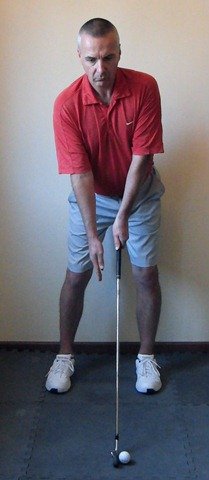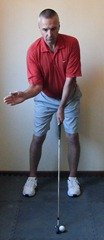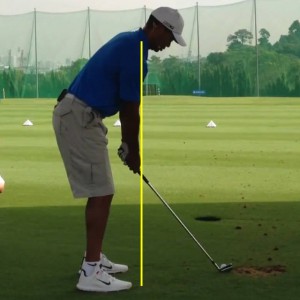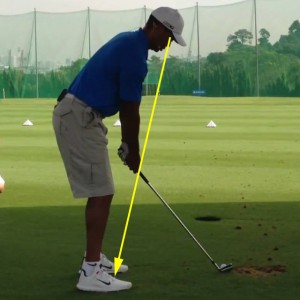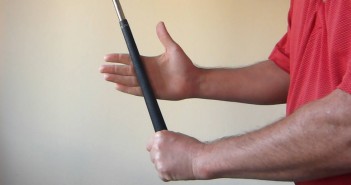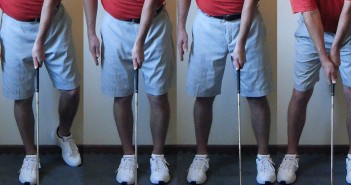This is the final piece of the puzzle in establishing the perfect golf posture, setting the stage for you to make a great golf swing.
A lot of instruction about arm position as you address the golf ball talks about the distance of the butt end of the club from your thighs, but this isn’t very useful or reliable, the precise distance will vary slightly depending on the length of the club and, more importantly, on the size and proportions of your body.
Once again, apologies to the lefties, for simplicity these instructions are given for a right-handed golfer.
The Perfect Arm Position at Address
As you take your stance with correct posture, the perfect stance width and ball position, perfect weight distribution and balance, and perfect spine angle, and then take your grip, tilt your spine and place the sweet spot of the club face behind the ball, your arms should hang, relaxed and free of tension, underneath your shoulders.
Your hands should hang between your feet, about level with your toes, and in front of the zipper on your trousers (which moved towards the target when you shifted your hips to tilt your spine) — see Figures 1 and 4.
If you let go of the club with your right hand, and let it hang freely near the club, it should not move either towards or away from your body, it should want to hang directly behind where it was on the grip — see Figures 1 and 2.
At address, your left arm should be straight, but not rigid or stiff, just naturally straight in a relaxed position. Your right arm should be very slightly bent.
Your right elbow will be slightly lower than your left, because of your spine tilt, but they should be perfectly parallel to the target line — see Figures 1 and 4.
Your upper arms should be more to the sides of your chest than in front of it, with the insides of your triceps and pectorals. Your shoulders should be in good posture, and you should feel connected. Your arms should be relaxed, not pressed towards each other. Your shoulders should also be perfectly parallel to the target line — see Figures 1 and 4.
The shaft of the golf club should be perpendicular to the target line, vertical when viewed from face on — see Figure 1.
Note that, when you place the address the golf ball, there will be some natural cupping (wrist extension) in your left wrist, and your right wrist will be flat — see Figure 1.
Externally Rotate Your Right Arm
Your left arm will be slightly internally rotated as it hangs naturally and moves around your chest to take your grip.
You should externally rotate your right arm, so that the front of your right elbow points directly away from you, and slightly to your right — see Figure 1.
As we will see in later articles, this is a small but crucial adjustment that will facilitate a much simpler golf swing, and help you to get the golf club perfectly on plane. For a brief description of this, see Internal and External Rotation of the Arms in the Golf Swing, which also describes how to increase your range of motion if you have trouble rotating your elbow to the right.
You can see this external rotation of the right arm more clearly if you let go of the club with your right hand, letting it hang freely near the club, and then flex your right elbow, your forearm should point away slightly to the right — see Figure 3.
Perfect Distance from the Golf Ball
The perfect distance from the golf ball is determined by your spine angle and the length of the golf club selected.
Your spine angle will change slightly depending on the length of the golf club — your spine will be more upright the longer the club — but this adjustment is only very small, and you’ll do it automatically as you stand further away from the ball with a longer club. This is only really noticeable with your driver, which we regard as a speciality shot, with which you will set up slightly differently; you will stand a little taller and your hands will be slightly higher at address — see Golf Swing 109 – Setup: How to Set Up for the Driver in the Golf Swing.
Standing more upright may push your hands away from your body very slightly as your chest pushes against your upper arms, but even with the driver your whole grip should be behind a line drawn vertically down from your chin at address — see Figure 5.
So, as you take your stance, as described above, with correct posture, the perfect stance width and ball position, perfect weight distribution and balance, and perfect spine angle, and then take your grip, tilt your spine and place the club behind the ball, your arms should hang, relaxed and free of tension, underneath your shoulders. When you do this the sweet spot of the club face should be precisely behind the golf ball.
Your body and arm position should be perfect, and that is what determines your distance from the golf ball — see Figure 4.
Once you have addressed the ball, never adjust your position to meet the ball. Never move your hands forwards or backwards, or adjust your spine angle or balance, in order to correct the position of the golf club. If you find that you are too close to, or too far from, the golf ball (you are not addressing the ball with the sweet spot of the club face), then stand up, adjust the position of your feet, and take your address position again from the beginning.
This may seem like a lot of hassle, but with a little practice you will set up correctly, quickly and instinctively standing the correct distance from the golf ball, the first time, every time.
Figure 6. Perfect distance from the golf ball – apparent hand position.
A great way to confirm your position, when you’re practising and out on the course, is to check your apparent hand position. This will vary a little, depending on your build, but when you are in the perfect position with an iron your right thumb will appear to be in-between the balls of your feet – see Figure 6. When you are working on this drill, check your position carefully in a mirror and make a mental note of where your thumb appears to be, relative to your feet, when you are in perfect address posture.
With the driver, your hands will appear to be further forwards – see Figure 5. You’ll naturally stand a little taller, and your arms will be pushed out a little more by your pecs, so your right thumb will appear to be a couple of inches outside your toes.
Remember to keep your chin up, your neck in good posture – inline with your spine. Another great position check is that, as a general rule of thumb, if you are in good posture, with your chin up and your neck in line with your spine, then you should be able to look at the ball clearly past the bridge of your nose, and not stand to tall, or have the ball so close, that you have to look down the length of your nose to see the golf ball.
Be disciplined, if it doesn’t feel exactly right then step away and start again. That way you will learn more quickly and play better golf.
Use Deliberate Practice
Remember what you discovered about how your mind learns in How to Learn a Great Golf Swing. Each time you practise your address position, use deliberate practice, find somewhere where you will be undisturbed, and really focus.
Take your stance in front of a mirror, checking each element of your position. Once you are more comfortable, address the ball before you look in the mirror, pause to feel if you’ve got it right before you confirm your position. If it doesn’t feel right before you look in the mirror, estimate the error. If you find that you didn’t get it exactly right, how is it different from the perfect position, and what does the error feel like? Revel in the joy of making mistakes, they mean you’re learning!
Every time that you perform any drill with a video camera, check your address position. You need detailed and regular feedback if you are to learn quickly.
As this address position becomes more natural, the feel, the feedback from your developing proprioception, will change. Work through the drill again and again, continuously adjusting what feels right, based on what the mirror and video camera tell you is really happening. Work in brief, highly focussed, sessions. Step away regularly and take your stance afresh, never just repeat drills mindlessly — it is not just about getting in the reps. Start working this drill into the other setup drills as you become more proficient.
If you have any questions or comments about this or other articles on Golf Loopy, please send us an email.
Next up: A description of how best to aim your golf swing, in Golf Swing 107 – Setup: Aim and Alignment.



